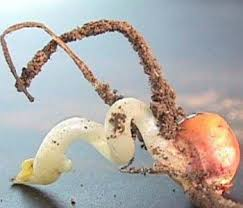Agronomy Update: Tips for a Successful Start to 2020
BY DAIRYLAND SEED AGRONOMY TEAM
Annual Spring Burndown
We are edging closer to the 2020 planting season every day, and we have a lot to accomplish before that hits! One thing we need to keep an eye on is emergence of early season weeds as our daytime temperatures consistently get into the 50’s and 60’s. With the challenges we had in 2019 with preventative plant acres and minimal fall spraying due to late harvest, I expect to see heavy weed pressure early in the season. A few keys to a successful start in a weed control plan are using effective SOA’s (Sites-of-Action), using correct herbicide rates, understanding proper timing, and utilizing residual herbicides. Nate Wyss, Market Development Specialist for Corteva in Western IN and Eastern IL, shares some recommendations:
Effective Burndown Herbicides:
2,4-D and dicamba are both are broad spectrum broadleaf herbicides that are strong on a large variety of weeds and will be the most common burndown partners. Metribuzin is a good product to consider for soybean burndown applications, especially where Marestail presence is heavy. For corn, utilizing products that contain clopyralid, such as Resicore and SureStart, will provide best-in-class control of large seeded broadleaves. A newer product to the market from Corteva is Elevore. Elevore has best-in-class control of Marestail and is on-label for controlling Marestail up 8” tall as well as being labeled for corn and soybeans. If grass has already started to emerge, an addition of glyphosate is a great asset.
Proper Timing:
As with most chemistries, most of the burndown products will work better in warmer temperatures. If we are making applications on days when our temperatures dip into the low 50’s and 40’s, you can expect control to be slowed or reduced. We also need to be considerate of our plant-back restrictions for products like 2,4-D and always follow label instructions for the rate you are using. Remember, with Enlist Soybeans you have no plant-back restriction when utilizing an Enlist herbicide!
Residual Herbicides:
We need to always utilize residual herbicides when creating our weed control plans, and burndown is the easiest time to add one in. Soybean products containing Group 14 chemistries like sulfentrazone (Authority) and flumioxazin (Valor) are our best options to add into any pre-emerge application. Key soybean products from Corteva would include Trivence, Sonic, and Surveil. Key corn products would include Resicore, SureStart, Fultime, and Cinch ATZ.
Use Correct Rates:
Making sure you understand how much active ingredient you are getting from your herbicides is key. There are many different types of 2,4-D and dicamba products, and rates can vary heavily from product to product. I recommend always contacting your local retailer or Corteva Crop Protection Territory Manager for specific rate recommendations that fit your acres.
Beware Of Rushing To Plant Corn Within 48 Hours Of A Wet/Cold Front
It won’t be long until planters are rolling and everyone is scrambling to get the 2020 crop into the ground. Typically, we see many wide swings in temperatures and moisture levels during planting season. It is important when the ground is fit for planting that you keep an eye on the local weather forecast.
|
Beware of trying to rush a corn planting in advance of a wet/cold front. Forcing in a corn planting within 48 hours of a wet/cold front may very well result in imbibitional chilling injury if soil temperatures fall below 50⁰ F with the potential for poor stands and possible need to replant. Imbibitional chilling injury occurs once a corn seed has imbibed water and is chilled within the first 48 hours to below 50⁰ F. Imbibitional chilling injury occurs when actively expanding cells rupture and become distorted. Symptoms of imbibitional chilling injury include; ‘leafing out” underground, poor emergence, irregular elongation and “corkscrewing” of mesocotyl. |
 |
Key points to keep in mind:
- If planting into dry soils and soil temperatures drop below 50 ⁰ F and corn seed has not imbibed water no significant injury occurs.
- Planting into moist soils with 50⁰ or less average temperature at seed depth may also result in imbibitional chilling injury.
- Within the first 48 hours the seed has imbibed water and a wet-cold front occurs after 48 hours will result in minimal to no injury. /li>
- A difference of six hours can make a difference between success and failure of establishing a good crop.
Key Reminders for Planting Corn
Planting Depth:
Plant 1.5-2” deep. Planting less than 1.5” deep, depending on weather and soil conditions increases the probability of the corn seed not germinating due to cooler soil temperatures or fluctuations in moisture in the seed zone.
Corn plants take in 30 percent of their weight in water during the germination process. By not having the proper planting depth, you risk seeds not fully germinating or not having enough moisture to continue to grow. Another forgotten reason to plant 1.5” or deeper, is that many herbicide labels state that to safely use that product, corn needs to be planted 1.5” or deeper, or injury may occur.
Soil Temperatures:
Plant when soil temperatures are 50°F or more, or when air and soil temperatures will be increasing to that level or more. Corn can germinate with temperatures less than 50°F, however, germination is more consistent at 50°F or more. If soil temperatures are in the low 40°F or less, you can increase the incidence of Imbibitional Chilling Injury or Cold Shock Syndrome, which can kill plants and subsequently reduce plant populations/harvestable ears. Cool wet soils increase the incidence of crown rot, as well as seedling diseases.
Starter:
I recommend utilizing a quality liquid starter and zinc to help the plant have an energy source (Phosphorus in the starter) and the ability to help move nutrients and protect the germination process (Zinc). It has been my experience that quality starter and zinc helps the corn “Pop Up” out of the soil and have better early season growth. It is also my observation that this early season growth translates to earlier tassel and pollination which in most cases leads to increased yields, better test weight and dry down.
Plant Populations:
My typical recommendation is to plant 1,000-1,500 more seeds than what is desired for a harvestable stand. Part of this is that not every seed will germinate as well as:
- Less than ideal planting seedbed
- Hail/Greensnap
- Wildlife I.E. Racoons, Skunks, Geese, Turkeys, Deer, grazing Cattle and in some southern states wild hogs may eat seeds or seedlings
- Seed and Seedling diseases
- Soil Types
The ability to variable rate plant has changed how we handle some of these issues, and is a tool that provides a better Return on Investment than increasing the seeding rate across the entire field.
If you have questions or concerns regarding this please contact your Dairyland Seed Representative or Agronomist.
 |
 |
 |
 |
 |
| Brian Weller Western Region 507.456.3034 |
Dan Ritter Central Region 219.863.0583 |
Branden Furseth Northern Region 608.513.4265 |
Rod King Eastern Region 574.596.6721 |
Terry Jones Eastern Region 419.630.3115 |
